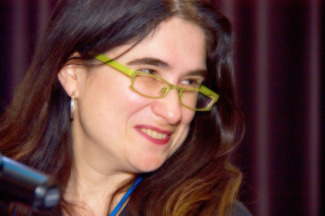Inés Sánchez de Madariaga, Director of the Women and Science Unit of the Ministry for Science and Innovation

"The low presence of women in leadership positions in both academic and research fields is a waste of talent which is unacceptable in this country"
According to Inés Sánchez de Madariaga, women’s presence in top academic positions is almost at a standstill, and therefore actions to eliminate bias and barriers are needed. This is also the view of thirty attendants at the three-day European Workshop “Leadership positions. How accessible are they for women in materials research?”, held in the Bellaterra Campus at the end of May. The meeting was organised by Maria Dolors Baró, Full Professor at the Materials Physics II Unit of the Physics Department at UAB, together with Wolfgang Mayrhofer, Full Professor at the University of Vienna.
Inés Sánchez de Madariaga is director of the Women and Science Unit (UMYC) of the Spanish Minister's Office for Science and Innovation and tenured lecturer of Urban Planning at the School of Architecture of Madrid. She earned her master's degree under a Fullbright scholarship from Columbia University, New York. She was also Visiting Scholar at Columbia University and at the London School of Economics and Political Science, as well as Jean Monnet Visiting Professor at the School of Architecture, University of Weimar-Bauhaus. She was executive consultant to the Spanish Minister for Housing and Vice Director General of Architecture, and member of the Executive Committee of the European Urban Research Association. She was also Spain's representative in the European Commission's Helsinki Group on Women and Science, and directed the first Spanish research group into gender, urban planning and architecture at the Technical University of Madrid. She has written six books and over thirty articles.
-Are there few women scientists in Spain?
-No, there are many. However, there is a lack of women in high-level leadership positions. As in many other professional fields, there is a glass ceiling which is difficult to break through and a sticky floor.
-And what is the reason for the lack of women in leadership positions?
-The main cause is related to structural problems of the scientific career, which is also subject to social stereotyping. The public image of the scientist is still connected with men, and the ‘scientific authority’ stemming from the knowledge is ascribed to them. There are factors concerning the organisation of scientific institutions and selection procedures that seem neutral but, in fact, bias exists, and this has negative effects on women.
-What is the current situation?
-Progress is very slow. In some fields we are even taking a step backwards; there are no female professors in areas like gynaecology, obstetrics and paediatrics. Only 15% of university professors in our country are women. At the Consejo Superior de Investigaciones Científicas (CSIC) this percentage increases up to 23%. This is because since 2005 gender equality in the composition of the evaluation committees was guaranteed. This had important effects till today, covering a period of increase of CSIC’s workforce.
-Is that the main action to take?
-This is one of the most important actions: to ensure gender equality in the composition of all evaluation committees. Several studies have demonstrated the existence of bias in the assessment of candidates applying for a full professor position. Under equal merits, women have less chance of getting a top position when they are not represented in the evaluation committees.
-Can women scientists complain about discrimination?
-Many studies have shown that bias definitely exists, and that its occurrence is often unconscious or involuntary. A study carried out in Sweden in 1997 showed that women applying for a membership in the Swedish Academy of Medicine had to obtain 2.5 points more than men in achieve the same mark. Another study performed in Spain about the habilitation needed to become full professor demonstrated that for every man in a seven-member evaluation committee, a female candidate with the same merits had 14% less chance of getting the position.
-What is your opinion about teaching a subject on gender issues in public universities?
-Endometriosis is a serious illness which affects 14 million women in Europe. It has only been considered as an illness in the European Union in 2005, but no money has been invested in its research; the cause is unknown and there is no specific treatment. This is just one example of the existence of gender bias in current scientific knowledge, and it is the result of low women’s presence in science. We need to eliminate these biases by including the gender dimension in research and teaching. This should bring about higher quality science.


